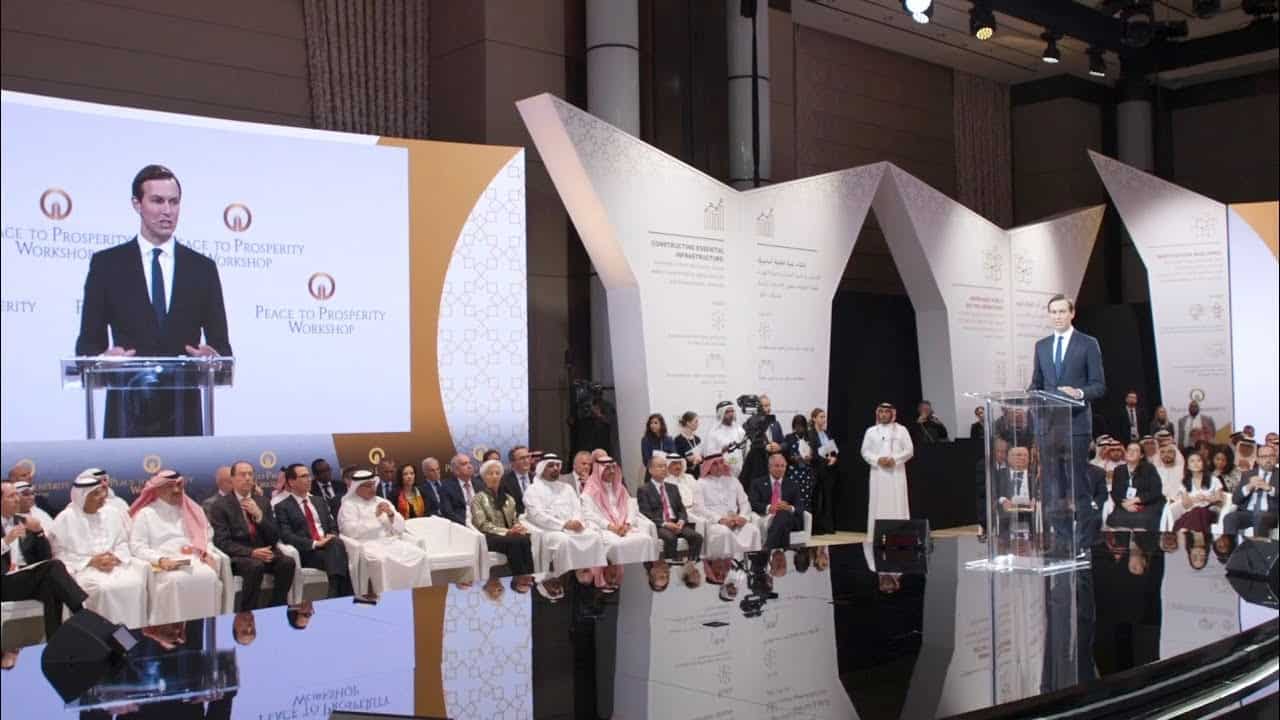Watching the Bahrain Peace to Prosperity workshop play out during the past week, I was reminded of the day when I arrived in Israel 20 years ago to assume my position as director of the U.S. government’s assistance program for the Palestinians. It was an exciting and hopeful time. Both the Palestinian and Israeli economies were growing rapidly and the security situation was calm. Several months earlier, the United States brokered the Wye River Agreement, which provided for further Israeli re-deployments in the West Bank and seemed to set the stage for the final push to resolve the outstanding issues. Seeking to reinforce this agreement, Congress appropriated $400 million over three years to supplement the annual $75 million Palestinian assistance program.
With the supplemental funds, the USAID Mission was tasked with designing a series of major infrastructure projects—a highway connecting Jenin and Nablus in the Northern West Bank, a desalination plant and water carrier in Gaza, a wastewater treatment plant in Hebron, a high-tech industrial zone in Tulkarm—while maintaining efforts to build Palestinian governance institutions. The goal was to ensure that Palestine was prepared economically and politically for the next phase of implementation of the Oslo Accords, namely the establishment of an independent Palestinian state. However, these plans were soon dashed. Following a failed summit at Camp David, the second intifada broke out, wreaking havoc with what had been a prevailing sense of relative security among both the Palestinian and Israeli populations.
Even as the initial violence broke out, the idee fixe of U.S. policymakers was that Palestinians would be unwilling to sacrifice their hard-earned economic gains and prospects for a better future by playing the violence card. Only when the violence continued for several months did the United States accept that economic progress alone could not bring stability to the region. Clearly, a political resolution was required. In June 2002, almost nine months after the violence first erupted, President Bush articulated the U.S. commitment to work toward a two-state solution—Israel and Palestine living side-by-side in peace and security—and the United States doubled down on pressing for political reform in the Palestinian territories.
A series of task forces were formed and precise benchmarks for measuring progress were established. When the Palestinians appointed Salam Fayyad, a respected official with the International Monetary Fund, as finance minister, the United States began providing budget assistance to the Palestinian Authority, as opposed to relying exclusively on contractors and grantees to implement the USAID program. Eventually, the intifada lost steam, Yasser Arafat died, the United States initiated a training program for Palestinian security, and the assistance program, once again, grew dramatically.
Critics, including senior Trump administration officials, tend to dismiss the impact of U.S. government assistance. They ask, what has truly been accomplished? Why has the Palestinian economy not transformed into a dynamic growth machine? Why have Palestinian institutions remained subject to corruption and incompetence?
In fact, much has been accomplished at the local levels. Palestinian society has better schools, health clinics, community centers, and technological capacities as the result of programs funded by USAID and other donors. The United States should take pride in these accomplishments, while recognizing that by themselves economic fixes in Palestine, like in every other country where USAID works, will not achieve the desired transformation that is the underlying premise of an assistance program.
This reality of localized successes is true notwithstanding the prohibitive constraints of closed borders, controls on the movement of people and goods within the West Bank and between the West Bank and Gaza, and a dependence on Israel for energy, water, and other basic services. However, to secure the desired returns on economic investments, whether from donor governments or the private sector, it’s important to think and work politically in a holistic fashion. In the Palestinian context, this means recognizing from the outset the underlying political causes of the conflict and considering approaches for resolving them. One of the lessons of the past 25 years is that an economics-first approach simply will not work.
The organizers of the Bahrain workshop purport to understand the need for a “political” element, but they have deferred release of this aspect of their plan until after the Israeli elections. This delay reflects nothing more than a desire to assist Israeli Prime Minister Benjamin Netanyahu’s political ambitions. Israelis should be demanding “show me the plan” so that they can make an informed choice in the upcoming elections based on how the multitude of parties react to the Trump administration’s proposals. Instead, the administration fears that even its modest efforts to prod the Israelis to make certain compromises regarding control of the West Bank will hurt Netanyahu’s electoral prospects.
Although Bahrain is not likely to generate the expectations associated a quarter century ago with Oslo, the breakthrough of a meeting in an Arab capital to discuss investments in the Palestinian economy should not be totally dismissed. Indeed, the plans put forward by the Trump administration, many of which admittedly resemble those of previous administrations, will provide a useful and bipartisan starting point when the time is ripe for serious negotiations over a long-term, political solution to the conflict. Let’s not wait until the tragedy of violence on the ground once again dominates the television screen.






